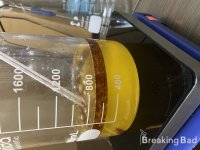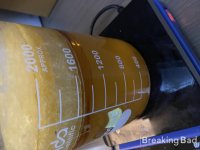- Language
- 🇺🇸
- Joined
- May 1, 2022
- Messages
- 323
- Reaction score
- 129
- Points
- 43
this is the preparation of P2P Phenylacetone CAS 103-79-7 made use of BMK Glycidic Acid ( sodium salt ) CAS 5449-12-7 with main ingredient sulfonic acid strength is 75% CAS 7664-38-2
-------------------------------------------------- ------------------------------
we are going to prepare 1 kg of BMK
take a 5 liter double neck flask
add 500ml boiling water . start with the mixer.
now slowly add 1kg of BMK salt. then add 1 liter of sulfonic acid. now connect the reflux and heat the contents of the flask to max temperature. plus minus 130°c. use a powerful mixer
Let it boil in reflux for 4 hours.
take the top layer and pour it into a measuring cup.
let the bottom layer cool and save for next time. ( we have no chemical waste for this preparation method )
now boil 1 liter of water and add it to the measuring cup. use a hand mixer to mix everything.
After mixing for a few minutes, let the measuring cup cool to room temperature.
remove the top white layer (this is water and waste that we don't need)
the bottom layer is P2P purified and ready to use.
ps: in this preparation we don't have to worry about water remaining in our P2P because water weighs less than P2P
ps2: if you keep these ratios, the P2P will have a ph value of 4 .
if you use more sulfonic acid the ph value will drop to 1. Therefore it is not necessary to use too much sulfonic acid.
-------------------------------------------------- ------------------------------
we are going to prepare 1 kg of BMK
take a 5 liter double neck flask
add 500ml boiling water . start with the mixer.
now slowly add 1kg of BMK salt. then add 1 liter of sulfonic acid. now connect the reflux and heat the contents of the flask to max temperature. plus minus 130°c. use a powerful mixer
Let it boil in reflux for 4 hours.
take the top layer and pour it into a measuring cup.
let the bottom layer cool and save for next time. ( we have no chemical waste for this preparation method )
now boil 1 liter of water and add it to the measuring cup. use a hand mixer to mix everything.
After mixing for a few minutes, let the measuring cup cool to room temperature.
remove the top white layer (this is water and waste that we don't need)
the bottom layer is P2P purified and ready to use.
ps: in this preparation we don't have to worry about water remaining in our P2P because water weighs less than P2P
ps2: if you keep these ratios, the P2P will have a ph value of 4 .
if you use more sulfonic acid the ph value will drop to 1. Therefore it is not necessary to use too much sulfonic acid.
Last edited by a moderator:
↑View previous replies…
- Language
- 🇬🇧
- Joined
- Jan 15, 2023
- Messages
- 387
- Reaction score
- 207
- Points
- 43
I tried your version of the synthesis, but did not use water, the synthesis takes place in microwave irradiation. At a certain moment, the temperature dropped sharply from 110 degrees to 50 degrees, the reaction was still violent. Have you noticed a drop in temperature as carbon dioxide emission starts?

- Joined
- Mar 29, 2024
- Messages
- 2
- Reaction score
- 2
- Points
- 3
buenas noches una pregunta de 1k bmk 5449-12-7. Relise con 1k fosforico. Baje al ph 3 purificado.
al final rindios. 200g polvo es normal o en q falle??
al final rindios. 200g polvo es normal o en q falle??
- Joined
- Mar 15, 2022
- Messages
- 645
- Solutions
- 1
- Reaction score
- 665
- Points
- 93
- Deals
- 8
Why you talk about sulfonic acid when the CAS is phosphoric acid? Are different products.



